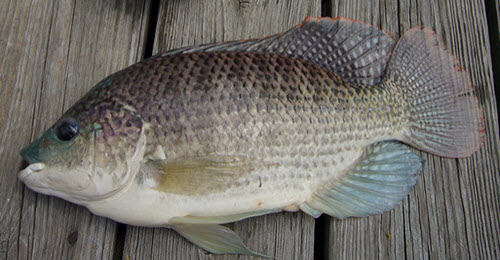ND41 Tilapia
The ND41 tilapia is a hybrid strain. This strain is produced by crossbreeding a male Blue tilapia (Oreochromis aureus) of the ND-1 Tilapia family line with a female Blue tilapia (Oreochromis aureus) of the ND-4 Tilapia family line. Both strains used to produce this strain are man-made. They have been developed by selective line breeding to make sure that they contain desirable genetic material. Using other strains of the same species will not produce the same result.
The main advantages of ND41 tilapia:

Wild Caught Blue tilapia (Oreochromis aureus). The ND41 Tilapia is breed by crossbreeding a female Blue ND-4 Tilapia with a male Blue ND-1 Tilapia. Photo by Michael Hayes.
- The ND41 tilapia is a mono-sex tilapia. All specimens are male. Some females might occur due to the risk of foreign genetic material present in the strain. The average proportion of males to females is therefore 98 percent. Two percent females are not enough to affect the productivity negatively. The presence of the females are therefore acceptable.
- This is a very fast growing strain of tilapia and it will outgrow Oreochromis nilotica in the temperature range 22-25 °C (72-77 °F). This makes them very suitable for facilities in colder areas. They grow slower in warm temperatures and in the temperature range 29-31 °C (84-88 °F) they grow slower than Oreochromis nilotica.
- The ND41 tilapia is a calm and docile strain making handling, sorting and harvesting very easy. Their compliant nature will help to greatly reduce fish fatalities associated with handling. It will also make it easier to produce visually appealing fish without thorn fins or other damages caused by fighting.
- Their docile nature reduce risk of injury and disease.
- The ND41 tilapia can be bred in very cold water. It can be both kept and produced in low temperatures (down to 20 °C / 68 °F), something which makes it ideal for use outside the tropics. You can read more about tilapia farming on cold climates here.
This strain has the same resilience as pure line Oreochromis niloticus to Streptococcus infection.

